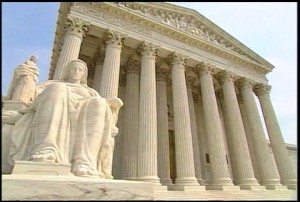So, the census is upon us again. It’s a time that many people, whether fo
Or does it? Just look at the highest judicial authority in the land, the Supreme Court. This group of nine justices oversees a judicial system that has grown exponentially. While originally set up to handle only the most controversial or difficult cases under the law, the Supreme Court received over 10,000 petitions in 2009. This is a very stiff burden for a true “court of last resort” to handle. In 1910, most people did not even know where to find a lawyer, but today the average person is more likely than not to be a party to a lawsuit at some point in life.
And as the legal system’s responsibilities have increased, so has the petty political infighting in judicial appointments. In 1910, Republican president William Howard Taft saw through party differences enough to elevate Edward White to Chief Justice, who was both a Democrat and a former Confederate soldier. And the senate at the time thought that its duty to affirm the appointments of new associate justices was in place to prevent incompetence, not press a political agenda. Today, judge Sotomayor’s confirmation was almost exclusively along party lines. And well, just about everything George W. Bush did during his second term was put to heavy scrutiny, including his judicial appointments. At the butt of the joke is a field of professionals who have committed themselves to being above the cracker-barrel, misleading political ideologies.
But the rise in the quality of medical care has perhaps presented the greatest change to the Supreme Court dynamics. Justices today are living longer, fighting fewer gentlemen’s duels, and just generally remaining productive far later in life. Justice Stevens is 89 years old, and although older justices have sometimes been criticized for their diminished mental faculties in the past (one even tried to commit suicide), there was a longstanding tone of passive respect for public officials in earlier eras. The same respect has not survived the century. Surrounded by a retinue to assist him, some have even questioned whether Stevens’ written opinions on the Court’s cases are, in fact, written by his young, inexperienced legal clerks. This would be a serious ethical violation, and the accusation is one stark indication of a political group that wants Stevens to retire so that Obama can fill the vacancy with an ostensibly more liberal justice. Others perceive the issue of age as something more systematic. They have discussed an amendment to the constitution that sets term limits for justices, whether through a mandatory retirement age or by defining a specific number of years that an appointment would last.
And if the Supreme Court is oddly criticized for excessive productivity, it can be imagined what is happening within the legal world as a whole. Certainly, the profession has done much better with producing qualified lawyers and judges than it has at actually finding needful roles for them to fulfill. Unemployment for lawyers at the entry level is at an all time high. Meanwhile, cases are taking longer to conclude, there are more of them, and decisions are appealed much more often. So in many ways, the legal field has changed in the same way others have. It is spurred to be more and more productive, while from all sides the costs are expected to be kept low. To all the overworked, underappreciated justices of the Supreme Court, we feel your pain.